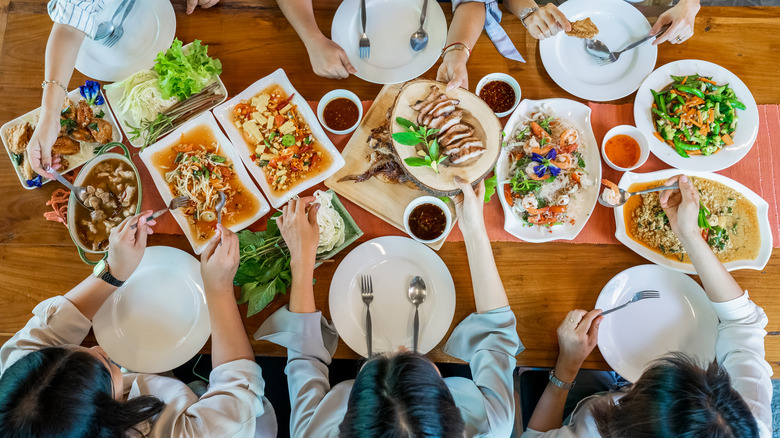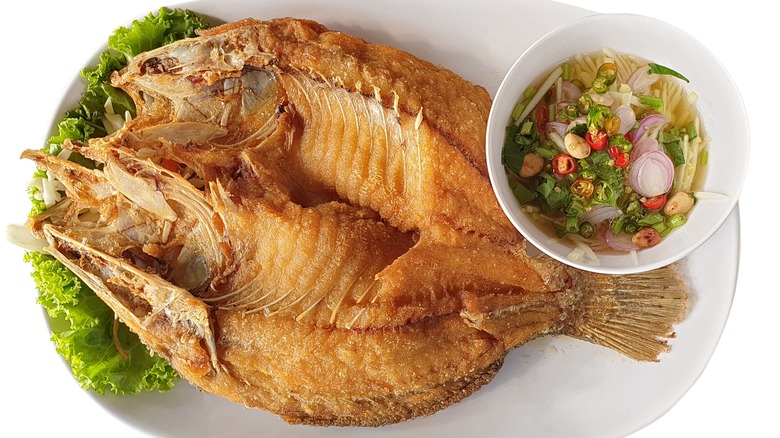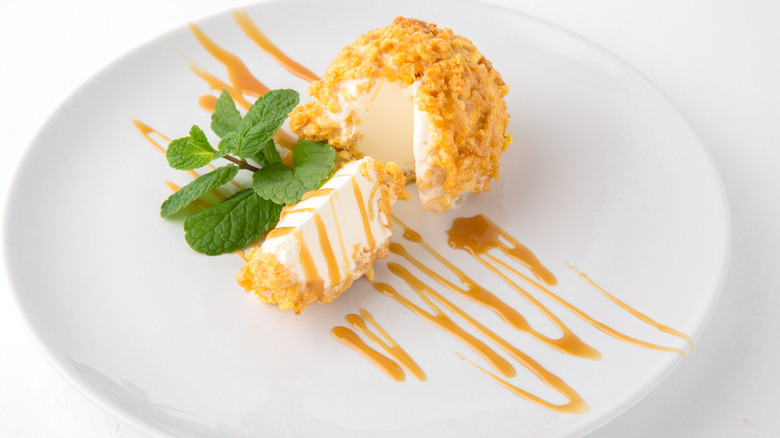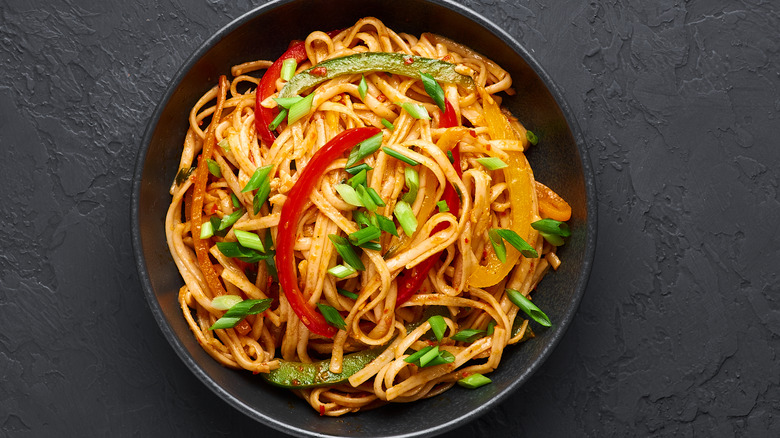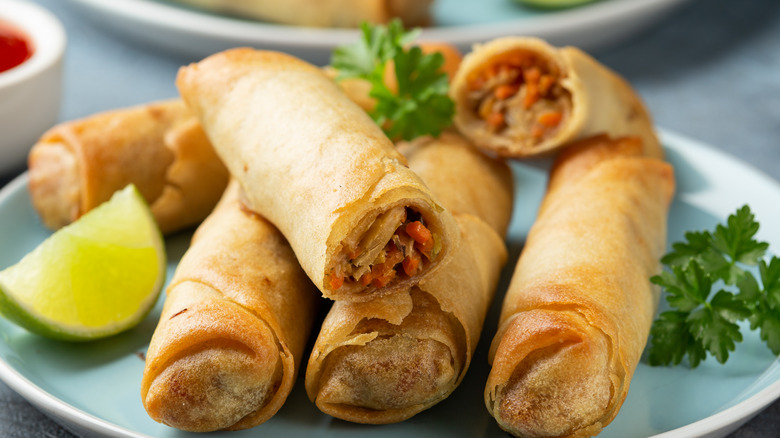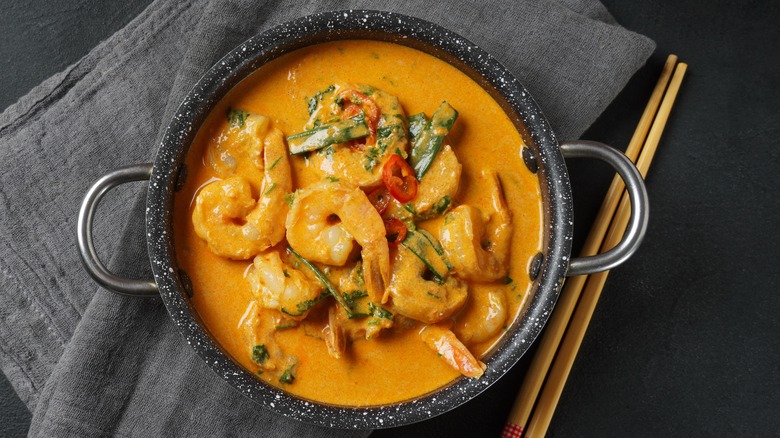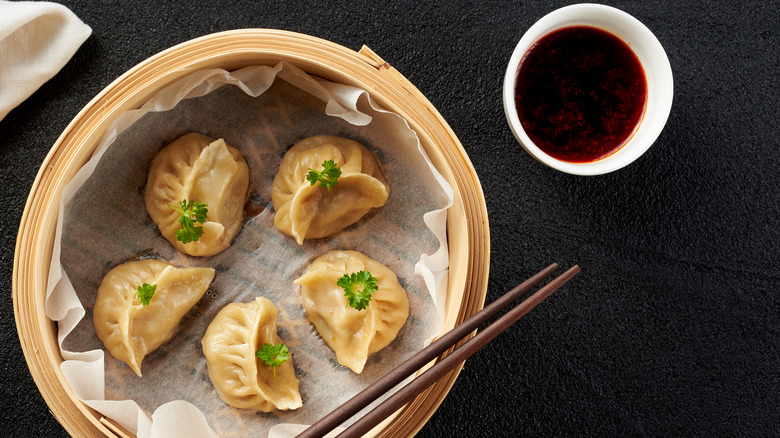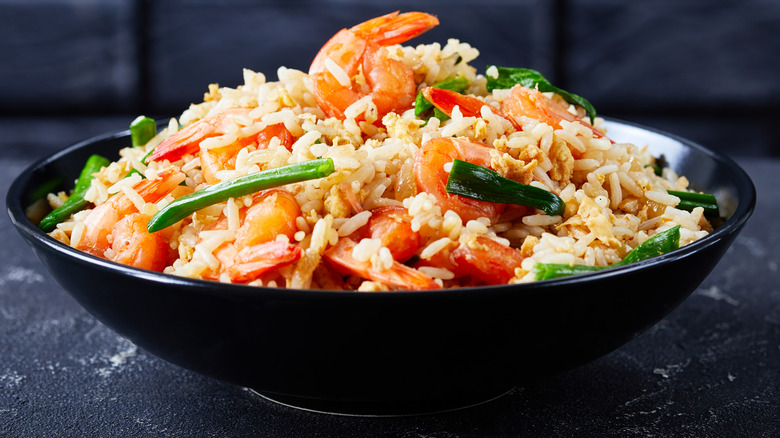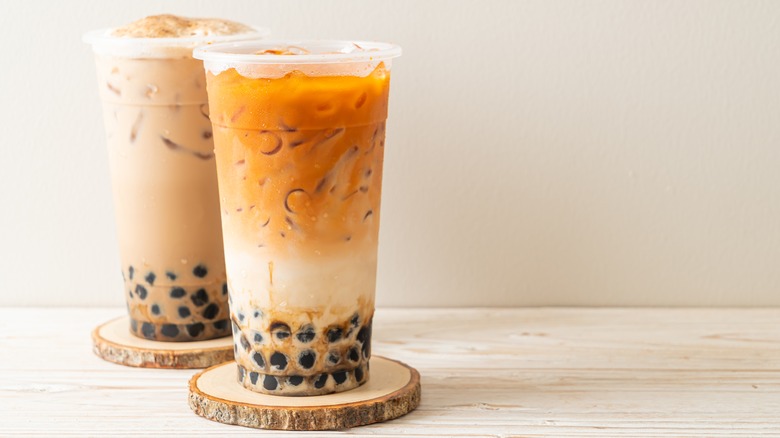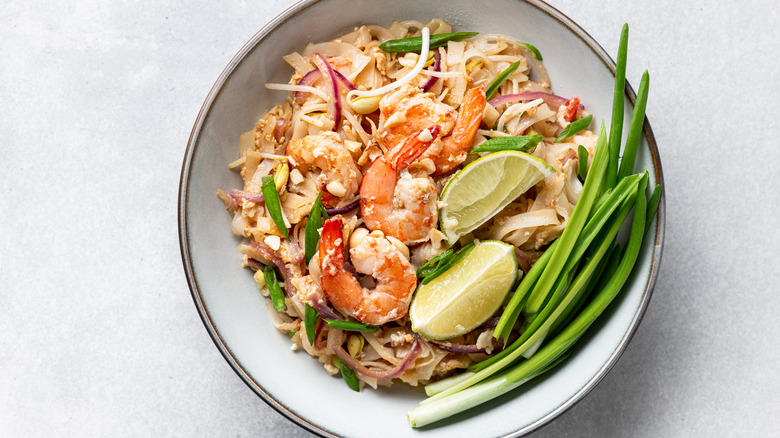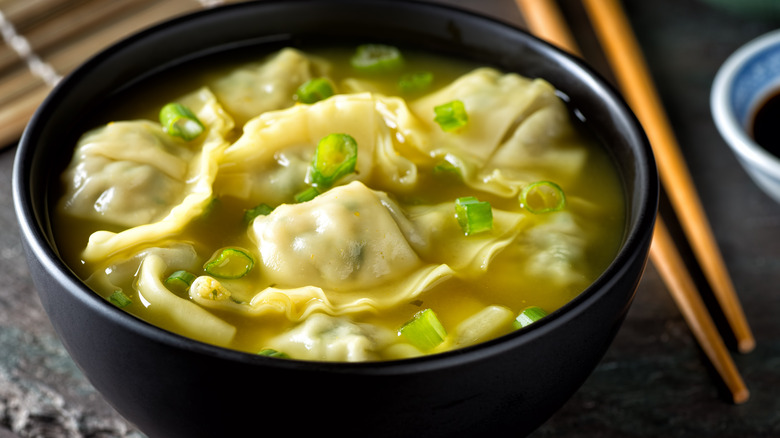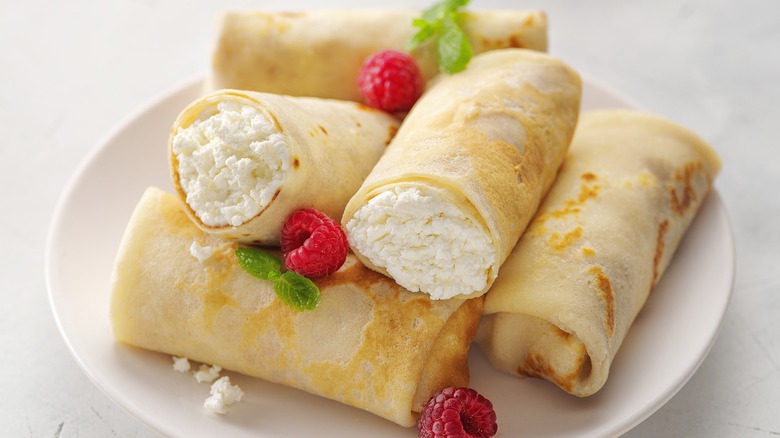What You Should Avoid Ordering At Thai Restaurants
Thai food is super popular worldwide, and for good reason. The cuisine combines a unique array of flavors that offer a mind-blowing dining experience. After all, it's not every day you find a single dish with sweet, salty, sour, and even bitter tastes in perfect proportion, but Thai food strikes an excellent balance.
However, there's a distinct peculiarity in the interaction of Thai food with American culture that's quite unlike the rest of the world. It's tempting to assume that Thai food was integrated into America by the immigration of natives from Thailand, but there are a few more twists to the story, as Mark Padoongpat, a Thai-American professor of Asian studies at the University of Nevada, Las Vegas discovered.
Thailand was never a formal U.S. colony, but by 1946, all of its surrounding Southeast Asian countries were colonies of seven world powers, most of whom were Western nations. According to Northern Illinois University, this meant that Thailand was treated like a U.S. colony. Americans visited freely, became immersed in the food culture, and even wrote Thai cookbooks for Western audiences. Marie Wilson, the wife of an exchange teacher, wrote the "Siamese Cookery" cookbook to export Thai food to America through the lens of a non-native ahead of Thai immigration. This means that there is a significant difference between authentic Thai food and its Western "Americanized" version, so if you're gunning for originality, there are a couple of things you shouldn't order at Thai restaurants.
Thai-style crispy fish
Like many of the greatest meals, the genius of Thai crispy fish was created to meet a specific need. Southern Thailand was — and still is — a fishing haven, so the locals invented multiple ways to maximize the deliciousness of fresh fish. According to Thaifoodmaster, the original crispy fish dish used fish taken straight from the fishing nets that was then marinated for a couple of hours in a mixture of lemongrass, peppercorns, curry, garlic, turmeric, and chili. Right after marinating, the spicy fresh fish would be deep-fried as a whole to mix the aroma of the soaking spices with the fresh flavor of the fish.
The original initiative created an extraordinary dish, but the conditions for recreating it were incredibly impractical in most parts of America. Over the years, there have been inevitable tweaks in the recipe to suit the available materials outside Southern Thailand. In most Thai-American restaurants, frozen fish or fish fillets are chosen for practicality, and there's hardly enough time to defrost and marinate them properly. There have also been changes in the spices, with some supplementing the fish with sauces to make up for the deficit. All of these tweaks have added up to create a version of crispy fish that Chef Tariq Nasir called "heavy with oil and lacking any real flavor" while speaking with Insider.
Fried ice cream
A mixture of the searing heat of frying oil with the sub-zero chill of ice cream is an exquisite and tantalizing paradox. At first glance, it seems impossible to fry ice cream, then the idea takes shape in the form of a thin ball of flour holding in an addictive and creamy filling. Fried ice cream would make an excellent Thai food order, except for a couple of major glitches.
Fried ice cream isn't originally Thai. According to Ice Cream From Scratch, its origins are still a subject of debate, but this debate only entails 18th-century history from Chicago, Philadelphia, Mexico, and China. Fried ice cream eventually became popular in Thailand, so the closest claim Thai cuisine has to the dish is for its variants. It's an excellent indulgence, but if you're gunning for an authentic Thai food experience, fried ice cream is the farthest possible choice.
Chow mein
It's impossible to picture how much can be done with noodles without exploring Asian cuisine. With the right infusion of spices, regular noodles can be transformed into a spectacular meal. This promise is what chow mein claims to deliver for most people, leading them to troop into Thai restaurants for a bite.
According to the Online Etymology Dictionary, "chow mein" is a derivative of the Chinese term "ch'ao mien" meaning "stir-fried noodles." The source of the name is the first clue as to why it's not a great Thai food choice -– it isn't even Thai! The Flavor and Fortune magazine of the Institute for the Advancement of the Science and Art of Chinese Cuisine explains that chow mein was created using noodles that were a Chinese staple from a time as early as A.D. 220. The evolution of regular noodles to ch'ao mien happened in diverse ways and at different times for most Chinese regions. In every place, the noodles were cooked differently.
Chef Ron Sambrano also reports that the most popular version of chao' mien in America is the Cantonese version with broccoli, carrots, mushrooms, broth, and a assortment of ingredients. The name of this Cantonese version was converted to "chow mein" in America, creating the dish most non-Chinese people now know.
This means that if you order chow mien at a Thai restaurant you are most likely getting food that's Cantonese, not Thai. Even worse, you could end up with any version of the many noodle variants!
Fried Thai spring rolls
Spring rolls come from an old, beautiful history that has aged like fine wine. In a time when Chinese people had no preservatives for fresh food, spring cultivation was a welcome change to their winter diet of dry food. The excitement was so pervasive that they held elaborate celebrations to usher in the season. According to The Taste, spring rolls were created to enjoy the fresh vegetables. The rolls were first made under the Chinese Jin Dynasty, but a 1992 study published in the Journal of Social Issues in Southeast Asia points to a "Chineseness" in the Kingdom of Siam, which was the origin of modern Thailand. With the amount of cultural diffusion between both places, these spring rolls are generally said to be both Thai and East Asian.
A marked difference between American and Asian cuisine, though, is that the American palate favors deep-fried over fresh. That's why it's not a surprise that Thai spring rolls in America are more popular in their deep-fried form. However, this frying is hardly a step up from the original spring rolls. In fact, many people affirm that the rolls taste much better as they were meant to be — fresh and unfried.
Instead of deep-fried Thai rolls, order rolls filled with vegetables, meat, or noodles that are wrapped in a thin layer of rice paper and enjoyed with a dipping sauce. Now, that's a meal that's 100% Thai, and it tastes so much better than the fried form!
Curry
For people who enjoy safe food choices, Thai curry is a haven of familiar comfort. The variation hardly goes beyond red, green, or yellow curry, so it's a predictable choice. If you think that's good, though, you're wrong.
While curry may seem like an easy dish, getting it right is intricate and time-intensive. For restaurants that can't strike that delicate balance, the easy way out may be to serve some bland, brightly-colored dish to customers who prize a safe meal over a delicious one.
According to Food & Wine, Thai curry is a product of a long evolution of spices and aromatics in the hands of Indian traders, Buddhist missionaries, and royal chefs from Southeast Asia. The herbs, umami spices, sauces, vegetables, and protein were added by multiple contributors across centuries to create the modern curry defined as "kaeng."
American cuisine is one of convenience, so when the dish was exported here, it was natural to create an easier alternative to mixing dozens of spices. In the American version of Thai curry, centuries of experimentation have been reduced to a canned curry paste thrown into a pot with coconut milk and protein to simmer. While this version is much easier to make, The New York Times puts it perfectly when it calls the resulting meal "tinny, stale, and unexciting." Without finding the one-in-a-million Thai restaurant willing to make it from scratch, there's a good chance your curry order will be rather boring.
Dumplings
Dumplings are a very special food. Ironically, what's so special about them is that the original dumplings aren't actually restricted to a particular culture. They're in a league with rice and beans — universal foods existing in almost every culture, but in different forms. The name "dumpling" refers to a wide range of dishes with a common structure of meat, vegetable, or cheese wrapped in dough. Cultures around the world have their unique twist on dumplings, so there are plenty of variations across the continents. Popular ones include the crescent-shaped Chinese Jiaozi, Indian Modak, Japanese pan-fried Gyoza, Shanghainese Xiao Long Bao, and Korean Mandu.
According to Chef One, many of these dumplings evolved differently, with multiple people independently conceiving the same idea. That's not surprising, seeing as warm food that maximizes available meat and infuses it with vegetables is a practical, non-complex idea. This origin isn't the same for Thai dumplings, also called Khanom Jeeb, though. While it has an original Thai spin, it's really just a variation of Chinese dim sum. Expectedly, it's also similar to nearly every other type of dumpling. America, being the world's melting pot, has nearly all of the other variations of dumplings. Amid such an overwhelming array of choices, it's nearly always better to experience a culture's cuisine through a dish that's unique to it. You can get dumplings anywhere, but you may not be able to get special Thai food outside of a Thai restaurant.
Thai fried rice
With American food and American versions of foreign food, there's one common similarity — the liberal use of grease, cream, and everything decadent. In the midst of so much relatively unhealthy indulgence, Thai meals help to even things out by providing tasty, yet healthy food. According to Healthline, Thai cuisine is even one of the healthiest compared to other cultures of the world. Unfortunately, this healthiness isn't exactly true with Thai fried rice.
According to Whetstone magazine, fried rice was an Asian innovation to help low-income families make the most of their leftover staples, most of which were vegetables and rice. As the dish evolved into a choice meal, people took advantage of the absence of a specific creator or static rules as to how fried rice should be cooked. Many cultures put their unique spins on the dish, and the Thai called theirs "khao phat".
Like other places, fried rice changed in America. As a dish of choice instead of need, the new additives made it less plain, but also less healthy. The switch from brown to white jasmine rice also downgraded some of the healthier bits of the meal, according to Medical News Today.
Ordering modern fried rice at a Thai restaurant means choosing a highly modified, much less healthy version of the original meal. Going out of your way to order Thai food should definitely offer better dividends.
Thai iced tea
On the surface, Thai iced tea seems like the perfect Oriental drink — a sweet accompaniment to the average spicy Thai meal. Upon digging deeper, however, there's context to the story that shows Thai iced tea as an over-sweetened Westernized impostor hiding in Thai menus.
Tea — the crop, not the drink — doesn't have a very long history with the Thai. According to Food & Wine, however, when tea moved to the forefront of import-export needs in the 1980s, it rapidly became popular. Though the import was focused on the economic uses of tea, usually for products like oil, medicine, and soap, the leaves also made a good drink. At an indiscernible time, it became popular to make tea with cold water and serve it as a casual drink or for streetside sale. Additives like condensed milk and ice also became popular in these drinks at some point.
When imported to America, this tea wasn't colorful, flavorful, or sweet enough for the American palate. The solution of the Thai restauranteurs was simple: sweeten the tea, add brighter colorants, and infuse some flavoring in it. The trick worked like magic, catapulting Thai iced tea to its current spot as an American favorite. However, it created a drink that's also entirely different from what resonates with authentic Thai food. With this lack of cultural roots, it's not uncommon to find Thai iced tea served as a sickly-sweet, over-flavored version of what it was originally meant to be.
Pad Thai
From the chicken to shrimp versions, Pad Thai — or what is known as Pad Thai in America — is one of the most popular Thai dishes in Western cuisine. If you're unsure about why it's so widely loved, a bite should be all it takes to convince you. Be careful while getting that bite, though, because you could be eating an entirely different food that's simply called Pad Thai.
The viral shock for American Pad Thai began in 2009 with Michelin star chef Gordon Ramsay. Slated to cook at the Wimbledon Thai temple, Ramsay made Pad Thai for Blue Elephant's Chef Chang to review ahead of his trip to the temple. As reported by US Weekly, upon tasting the meal, Chang said with an insulted look on his face "This is not Pad Thai at all, no. Pad Thai has to be sweet, sour, and salty."
While the response was a shock to Chef Ramsay and a source of intense amusement to most pop-culture enthusiasts, the reason behind it was simple –- the dish made in America is a far cry from authentic pad Thai. According to Far & Wide's analysis of authentic and American pad Thai, the spices, vegetables, and garnishes are all different. Short of finding an American restaurant that can source fresh vegetables in season, alongside fresh chai po waan, mung sprouts, and other Thai additives for pad Thai, the only place to get the authentic dish would be in its home, Thailand.
Wonton soup
Wonton soup is another Asian dish that achieved radical fame outside the shores of its country of origin. For many Americans, it's a favorite order at Thai restaurants. While wonton is a crowd-pleaser, the accuracy of its place on a Thai menu needs some more scrutiny.
This soup filled with thinly-wrapped shrimp or pork dumplings is, in fact, not a Thai dish. According to Tourism Richmond, the wonton originated as a meal of upper-class Chinese families sometime between 1644 and 1912, during the reign of the Qing dynasty. It was imported to America as a Chinese dish, but the chefs felt the need to tweak it to accommodate more American choices.
This decision was two-edged because while it created delicious fusion foods like the cream cheese wonton, it also allowed diverse American experimentation. American versions mostly included frozen dumplings and massive, hastily-wrapped shrimp that tasted bad enough to birth a Quora thread infamously titled, "Who invented the appalling American wonton?"
With so much variation, it was only a matter of time before the lines between Chinese and Thai blurred, and America wonton was mistaken to be Thai food. The dish is great, and the cream cheese variant is an excellent exploration of cultural fusion. However, a Thai restaurant isn't the spot for it. A Chinese restaurant would be a better, more original choice instead. Historical accuracy aside, you're much less likely to run into "appalling American wontons" when you opt for originality.
Cheese rolls
Cheese rolls are similar to spring rolls, but stuffed with a cheesy filling. This filling is usually mozzarella or cheddar cheese mixed with an assortment of herbs and spices. The place of cheese rolls on a Thai restaurant menu is particularly amusing because cheese isn't really a part of the Thai diet at all.
Per CNN Travel, cheese rolls originated in New Zealand, far from Thailand and its neighboring countries. It's also a relatively new dish, with the first recorded recipe only dating as far back as the 1930s. If there was a Thai version of the dish before or at this time, it would have been recorded. Thus, the chance that cheese rolls have Thai roots is zilch.
These rolls most likely found their way onto Thai menus through the same Western influence that altered many of the authentic dishes. While these Western additions may have helped Americans acclimatize better to Thai cuisine, it doesn't make them any less unoriginal. Cheese may not have been very popular in early Thailand, to begin with, but it isn't an integral part of Thai cuisine for a reason. Thai food incorporates the kind of meat, vegetables, herbs, and spices that cheese remains at odds with. In the midst of dishes that represent centuries of innovation and genius, a cheese roll simply doesn't have a place at the table in a Thai restaurant.
